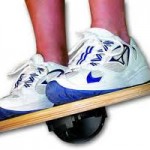 Sprain an ankle recently?….Not the first time??
Sprain an ankle recently?….Not the first time??
Not only are ankle sprains one of the most common injuries, but recurrent sprains of the same ankle are not unusual. It’s typical for people to chalk it up to “weak ankles,” consider themselves healed once they can walk without a limp, and resign themselves to a fate of repeated sprains. But they’ve got it wrong.
Weakness of the muscles around the ankles is a factor, but even more important for the prevention of ankle sprains is the strength of the muscles around your hips and a finely tuned sense of proprioception. Hip muscles such as the gluteus medius (upper, outer butt) play a vital role in maintaining your overall balance. Strengthening these, along with your core, is essential (shallow, single leg squats are an effective method). Very simply, the more stable your body on the whole, the less unsteadiness your ankle has to compensate for.
The other big factor is proprioception, i.e. your body’s sense of position. Proprioception is a function of your nervous system. It is what notifies your brain that your ankle joint has turned inward 2 mm so that it can immediately signal the necessary muscles to adjust accordingly. This is how your body maintains balance and prevents injuries in the face of ever-changing joint positions. Ultimately, it doesn’t much matter how strong your ankle muscles are if they don’t even kick in until three seconds after your ankle has twisted. When you sprain an ankle, you don’t just injure the ligaments, you also injure the nerves associated with the joint, including the ones responsible for feedback loops like proprioception. While most ligaments eventually heal, the nerves require re-training in order to resume working properly. Balance exercises on unstable surfaces such as foam pads, wobble boards and BOSU trainers are helpful for this proprioception re-training.
TIP: Rehabilitation of ankle sprains is not complete until full function is restored–strength, range of motion, and coordination. In addition to ankle muscle strengthening, rehabilitation needs to include hip/core strengthening as well as proprioceptive re-training.

3 Comments